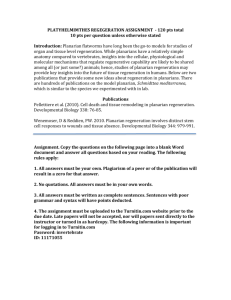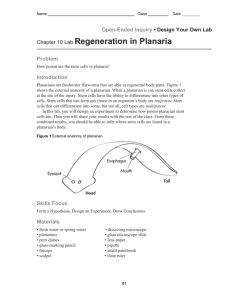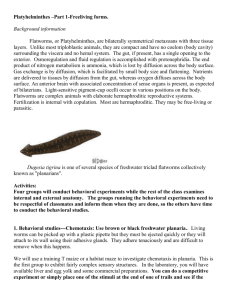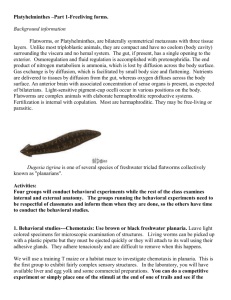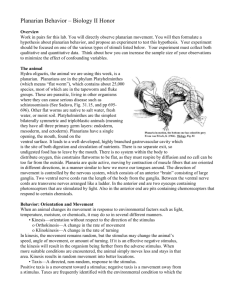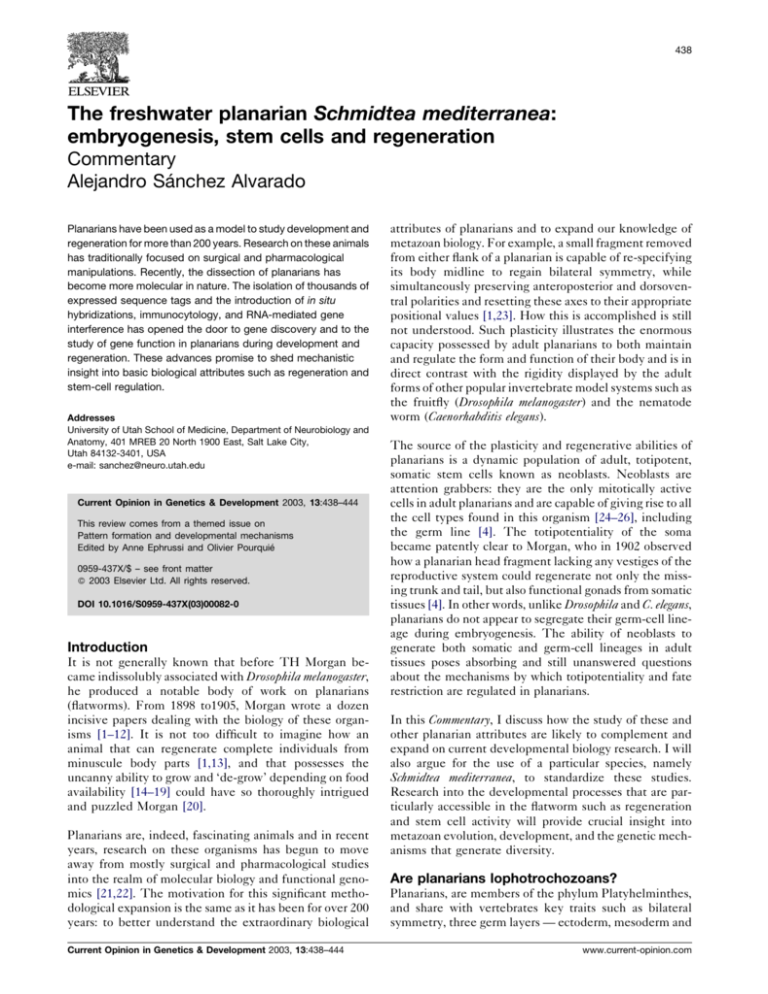
438
The freshwater planarian Schmidtea mediterranea:
embryogenesis, stem cells and regeneration
Commentary
Alejandro Sánchez Alvarado
Planarians have been used as a model to study development and
regeneration for more than 200 years. Research on these animals
has traditionally focused on surgical and pharmacological
manipulations. Recently, the dissection of planarians has
become more molecular in nature. The isolation of thousands of
expressed sequence tags and the introduction of in situ
hybridizations, immunocytology, and RNA-mediated gene
interference has opened the door to gene discovery and to the
study of gene function in planarians during development and
regeneration. These advances promise to shed mechanistic
insight into basic biological attributes such as regeneration and
stem-cell regulation.
Addresses
University of Utah School of Medicine, Department of Neurobiology and
Anatomy, 401 MREB 20 North 1900 East, Salt Lake City,
Utah 84132-3401, USA
e-mail: sanchez@neuro.utah.edu
Current Opinion in Genetics & Development 2003, 13:438–444
This review comes from a themed issue on
Pattern formation and developmental mechanisms
Edited by Anne Ephrussi and Olivier Pourquié
0959-437X/$ – see front matter
ß 2003 Elsevier Ltd. All rights reserved.
DOI 10.1016/S0959-437X(03)00082-0
Introduction
It is not generally known that before TH Morgan became indissolubly associated with Drosophila melanogaster,
he produced a notable body of work on planarians
(flatworms). From 1898 to1905, Morgan wrote a dozen
incisive papers dealing with the biology of these organisms [1–12]. It is not too difficult to imagine how an
animal that can regenerate complete individuals from
minuscule body parts [1,13], and that possesses the
uncanny ability to grow and ‘de-grow’ depending on food
availability [14–19] could have so thoroughly intrigued
and puzzled Morgan [20].
Planarians are, indeed, fascinating animals and in recent
years, research on these organisms has begun to move
away from mostly surgical and pharmacological studies
into the realm of molecular biology and functional genomics [21,22]. The motivation for this significant methodological expansion is the same as it has been for over 200
years: to better understand the extraordinary biological
Current Opinion in Genetics & Development 2003, 13:438–444
attributes of planarians and to expand our knowledge of
metazoan biology. For example, a small fragment removed
from either flank of a planarian is capable of re-specifying
its body midline to regain bilateral symmetry, while
simultaneously preserving anteroposterior and dorsoventral polarities and resetting these axes to their appropriate
positional values [1,23]. How this is accomplished is still
not understood. Such plasticity illustrates the enormous
capacity possessed by adult planarians to both maintain
and regulate the form and function of their body and is in
direct contrast with the rigidity displayed by the adult
forms of other popular invertebrate model systems such as
the fruitfly (Drosophila melanogaster) and the nematode
worm (Caenorhabditis elegans).
The source of the plasticity and regenerative abilities of
planarians is a dynamic population of adult, totipotent,
somatic stem cells known as neoblasts. Neoblasts are
attention grabbers: they are the only mitotically active
cells in adult planarians and are capable of giving rise to all
the cell types found in this organism [24–26], including
the germ line [4]. The totipotentiality of the soma
became patently clear to Morgan, who in 1902 observed
how a planarian head fragment lacking any vestiges of the
reproductive system could regenerate not only the missing trunk and tail, but also functional gonads from somatic
tissues [4]. In other words, unlike Drosophila and C. elegans,
planarians do not appear to segregate their germ-cell lineage during embryogenesis. The ability of neoblasts to
generate both somatic and germ-cell lineages in adult
tissues poses absorbing and still unanswered questions
about the mechanisms by which totipotentiality and fate
restriction are regulated in planarians.
In this Commentary, I discuss how the study of these and
other planarian attributes are likely to complement and
expand on current developmental biology research. I will
also argue for the use of a particular species, namely
Schmidtea mediterranea, to standardize these studies.
Research into the developmental processes that are particularly accessible in the flatworm such as regeneration
and stem cell activity will provide crucial insight into
metazoan evolution, development, and the genetic mechanisms that generate diversity.
Are planarians lophotrochozoans?
Planarians, are members of the phylum Platyhelminthes,
and share with vertebrates key traits such as bilateral
symmetry, three germ layers — ectoderm, mesoderm and
www.current-opinion.com
The freshwater planarian Schmidtea mediterranea: embryogenesis, stem cells and regeneration Sánchez Alvarado 439
endoderm — and dorsoventral and anteroposterior polarities. Planarians are also among the simplest bilaterians
to display cephalization — that is, a complex and wellorganized accumulation of neurons in their anterior
region. These characteristics have attracted the attention
of a long succession of zoologists, and the taxonomic
history and classification of the flatworms have been
issues of considerable controversy. On this topic, the
great invertebrate biologist Libbie Hyman wrote,
‘‘throughout the nineteenth century the number of
arrangements published was about equal to the number
of interested zoologists’’ [27]. More recently, however,
consensus is building to place planarians into a new
taxonomic group known as the Lophotrochozoa [28,29],
although some dissention still exists [30]. The Lophotrochozoa, by definition, is composed of a large group of
monophylectic, protostome taxons that have either a
lophophore (i.e. a set of tentacles surrounding the mouth
used for feeding) or that develop through a free-swimming, ciliated (trochophore) larva [31]. In this scenario the
Lophotrochozoa is a sister group to the Ecdysozoa — a
group that includes arthropods and nematodes, among
others (Figure 1) [29] — and the Deuterostomes (see the
review by Tessmar and Arendt in this issue). It should be
noted, however, that planarians lack a lophophore and
that even though marine planarians such as the polyclads
develop through a type of trochophore larva known as
Müller’s larva, this is not true of freshwater planarians,
which, in fact, are direct developers (see below).
The diversity of developmental strategies and morphologies of free-living flatworms and other non-ecdysozoan
protostomes makes it difficult to establish phyletic and
interphyletic relationships using morphological characters alone. Presently, there is much acknowledged uncertainty about the intra-lophotrochozoan phylogenies [29].
For instance, on the basis of combined analyses of morphology and molecular data, it has been suggested that
the acoelomate worms (including the Platyhelminthes)
should be placed in an independent sister group to the
Lophotrochozoa named the Platyzoa [32]. Because lophotrochozoans and platyzoans share a predominantly spiral
mode of embryonic cleavage, it has been proposed that
they be combined to create the superphylum Spiralia [33]
(Figure 1). It is clear, therefore, that to create phyletic
relationships of sufficient resolution and completeness,
more molecular information on non-ecdysozoan protostomes is needed. Recently obtained cDNA sequence
data from the freshwater planarian Schmidtea mediterranea
[22] should help improve not only the reliability of intraphyletic relationships in this group of animals but also
general hypotheses of metazoan body-plan evolution.
If not by spiral cleavage, how do the embryos
of freshwater planarians develop?
Although much is known about the embryogenesis of
other orders of flatworms such as the marine polyclads
www.current-opinion.com
Figure 1
(a)
Deuterostomes
Protostomes
Ecdysozoans
Lophotrochozoa
(b)
Deuterostomes
Protostomes
Ecdysozoans
Platyzoa
SPIRALIA
Lophotrochozoa
Current Opinion in Genetics & Development
Two different assemblies of the metazoan tree of life. (a) The tripartite
model of metazoan evolution [29]. (b) A different inference on the
phyletic relationships of the non-ecdysozoan animals in which the
acoelomate worms are grouped into the Platyzoa [32] to distinguish
them from all other protostome worms (Lophotrochozoa). In this view,
the Platyzoa and Lophotrochozoa are assembled into a ‘super-phylum’
named the Spiralia because of the predominantly spiral mode of
cleavage of the embryos of these animals [33].
[34] and the acoels [35,36], little contemporary work has
been done on the embryos of freshwater planarians
[37–39]. To my knowledge, the last detailed studies of
the highly derived embryogenesis of freshwater planarians were carried out by Metschnikoff (1883) [40], Ijima
(1884) [41], Hallez (1887) [42], Korschelt and Heider
(1895) [43], Mattiesen (1904) [44], and Fulinski (1916)
[45]. Part of this body of work is shown in Figure 2. Unlike
the typical quartet spiral cleavage of marine polyclads
[34], and the modified duet cleavage of acoel flatworms
[36], the pattern of cleavage in freshwater planarian
embryos seems anarchic by comparison. The embryos
are, in fact, ectolecithal (i.e. yolk cells reside outside
rather than inside the embryo; Figure 2a,b) [20], and
the leitmotiv of the early developmental stages appears
to be the internalization of the yolk cells (Figure 2e–k).
Current Opinion in Genetics & Development 2003, 13:438–444
440 Pattern formation and developmental mechanisms
Figure 2
(a)
(b)
(c)
Zygote
(d)
Outer layer
Yolk cell
Outer layer
Blastomere
Embryos
Blastomere
Yolk cells
Egg shell
(e)
(f)
(g)
(h)
(i)
(j)
(k)
(l)
Yolk cells
Outer layer
Embryonic wall
Current Opinion in Genetics & Development
The embryogenesis of freshwater planarians. (a) A group of six zygotes surrounded by a mass of yolk cells (the capsule has been omitted for simplicity.
See main text). (b) A single zygote surrounded by yolk cells displaying the blastomere-derived outer layer filled with dividing blastomeres. (c) A fully
developed embryonic sphere. (d) A cross-section of an egg capsule showing three embryonic spheres surrounded by yolk cells. (e–h) Developmental
stages of the temporary (embryonic) pharynx and intestine. In these images, the pharynx is towards the bottom of the panels and the intestine towards
the top. (i) The differentiated temporary pharynx and intestine. (j) Initial steps in the internalization of yolk cells through the temporary pharynx.
(k) An embryo with its temporary intestine distended and filled with yolk cells. (l) Initialization of embryo flattening, and resorption of the temporary
pharynx and intestine. In images (c–j) the external yolk cells have been omitted for simplicity. (a–c,e) after Ijima [41]; (d,j) after Metschnikoff [40];
(f–i) after Mattiesen; (k,l) after Fulinski [45].
After fertilization, several zygotes (two to six) are encapsulated along with a mass of yolk cells (Figure 2a). As the
fertilized egg divides, the cleavage progeny remain barely
in contact with each other and some of the blastomeres
begin to flatten to form a spherical, one-cell-thick outer
layer that effectively surrounds the remaining blastomeres (Figure 2b,c). The outer layer and the blastomeres
it encloses form what is known as an embryonic sphere
[27]. The internal blastomeres continue to divide
(Figure 2c), and as the embryonic sphere develops, some
of the scattered blastomeres begin to aggregate near the
outer layer (Figure 2e), where they differentiate into a
temporary pharynx and a temporary intestine (Figure 2f–i).
Current Opinion in Genetics & Development 2003, 13:438–444
The temporary pharynx begins to ingest yolk cells
(Figure 2j), filling and distending the temporary intestine
until it is in close proximity to the outer layer (Figure 2k).
The yolk internalization process transforms a spherical,
hollow embryo into one that possesses three presumptive
tissue layers: an outer cell layer; an embryonic digestive
system filled with yolk; and a compacted layer of blastomeres, or embryonic wall [46] bounded externally by
the outer layer and internally by the distended temporary
intestine (Figure 2k,l).
At first glance, one could consider these morphogenic
events akin to gastrulation. However, neither the outer
www.current-opinion.com
The freshwater planarian Schmidtea mediterranea: embryogenesis, stem cells and regeneration Sánchez Alvarado 441
Figure 3
(a)
(b)
(c)
(d)
Current Opinion in Genetics & Development
Fluorescent immunocytochemistry of Schmidtea mediterranea embryos. Four progressive stages of development after the resorption of the embryonic
pharynx are shown. Embryos were stained with anti-phospho histone H3 antibody to visualize mitotic cells (red). Differentiated tissues such as the
definitive pharynx were detected using an anti-phospho tyrosine antibody (green). In all panels, anterior is to the left. All views are ventral. The
fluorescent images are superposed on the bright-field images (gray). (a) Initiation of proliferation of blastomeres in the embryonic wall. (b) Initial
invasion and proliferation of cells from the embryonic wall into the yolk-cell compartment (yellow arrowhead) is accompanied by the initial stages of
differentiation of the definitive pharynx (white arrowhead). (c) Branching of the intestine becomes apparent as rows of proliferating cells (yellow
bracket) appear in the yolk-cell compartment. Pharynx differentiation is more advanced as evidenced by the appearance of its lumen (white
arrowhead). (d) A flattened embryo with a well-developed pharynx (white arrowhead). At this stage, the embryos display negative phototaxis, yet no
obvious differentiated photoreceptors can be observed. Note the absence of anti-phospho histone H3 signal at the anterior-most end of the animal.
Scale bars are 100 m in (a) and 200 m in (b–d).
layer nor the distended embryonic intestine and its
pharynx will form part of the embryo, as these tissues
are resorbed. In fact, the entire animal develops directly
from the embryonic wall, where the compacted blastomeres begin to proliferate rapidly (Figure 3a) and then
invade and consume the yolk cells to form a digestive
sac. As development proceeds, the permanent pharynx
appears (Figure 3b) and branching of the digestive
system begins (Figure 3b). Flattening of the embryo
now becomes apparent (Figure 3c), the branching of the
gastric system is more pronounced (Figure 3c), and the
ventral epithelium differentiates cilia for eventual locomotion (not shown). One to two days later, the embryo
is motile, with a well-developed pharynx (Figure 3d)
and a branched gastric cavity (Figure 3d). Thus, it
would appear that in the absence of a well-defined
series of gastrulation events, the embryonic wall establishes anteroposterior and dorsoventral axes, and produces a central nervous system, mesenchymal tissue, and
a digestive system. Unfortunately, nothing is yet known
about the inductive processes that must be taking
place in the embryonic wall to produce the definitive
www.current-opinion.com
endoderm, mesoderm, and ectoderm of the freshwater
planarian.
The embryos of Schmidtea mediterranea are
accessible to molecular studies
To learn more about the embryogenesis of freshwater
planarians, it is necessary to have ready access to large
numbers of embryos and to develop the necessary techniques to study them at the molecular and cellular level.
To accomplish this task, my laboratory has chosen to
develop S. mediterranea as a species in which to carry out
embryological and molecular developmental studies.
There are several advantages to using S. mediterranea over
other freshwater planarians, and these have been summarized recently elsewhere [20]. One such advantage, is
that S. mediterranea exists as both sexual worms that
reproduce as cross-fertilizing hermaphrodites and asexual
worms that reproduce strictly by transverse fission [20].
Because the sexual strain is also capable of regeneration,
it has been possible to establish clonal lines of this animal
in the laboratory by serially amputating adult worms and
Current Opinion in Genetics & Development 2003, 13:438–444
442 Pattern formation and developmental mechanisms
allowing the fragments to regenerate. Previous attempts
to sexually propagate freshwater planarians in captivity
resulted in either low fecundity or progeny that were
infertile [47]. Recently, however, my laboratory has succeeded in breeding clonal lines of the sexual strain of
S. mediterranea that produce fertile progeny, effectively
overcoming existing limitations (visit http://planaria.
neuro.utah.edu for a movie of an animal laying an egg).
This is allowing us to generate inbred lines for genomic
and genetic analyses, as well as to begin a detailed
molecular and morphological characterization of the
embryogenesis of this species (Figure 3).
vides us with a unique scenario in which to compare and
contrast the roles played by known developmental genes
during embryogenesis and regeneration. For instance,
would elimination by RNAi of developmental genes such
as Otx, Otd, and Pax6 in S. mediterranea embryos result in
noticeable phenotypes? If such genes are required for
development but not for regeneration, the regulatory
elements governing the expression of these and other
genes should provide us with mechanistic insight on the
differences and similarities that may exist between development and regeneration.
Embryogenesis and the planarian stem cells
Bilaterian development, regeneration and the
embryos of Schmidtea mediterranea
As counterintuitive as it may sound, studying the highly
modified embryogenesis of freshwater planarians is
bound to expand our understanding of common regulatory processes operating during bilaterian development.
By determining the molecular events leading to celldetermination and differentiation in the ectolecithal
embryos of S. mediterranea (Figure 2), it should be possible to recognize plesiomorphic bilaterian features
shared by the ecdysozoans, lophotrochozoans and deuterostomes. Such studies would help inform theories on
the evolution of the bilateria [48]. Additionally, we also
know S. mediterranea to possess genes that are absent in
the genomes of C. elegans and Drosophila, but present in
Homo sapiens [22]. Because it is likely that some of the
genetic differences that exist between ecdysozoans and
S. mediterranea will be manifested during embryogenesis,
identifying common regulatory processes between planarians and deuterostomes should allow us to better
define interphyletic relationships (see the review by
Tessmar and Arendt in this issue). This is, in part,
exemplified by the recent characterization of nou darake
in planarians [21], a fibroblast growth factor receptor like
protein found in humans but absent in C. elegans and
Drosophila. This molecule plays a key role in regulating
the inductive interactions involved in the formation of the
central nervous system in planarians and in regulating the
FGF pathway in vertebrates [21]. However, the role of
nou darake during planarian embryogenesis is not known.
Because planarians and vertebrates share nou darake,
defining its expression pattern and function during the
development of S. mediterranea is likely to provide new
information not only on planarian but on deuterostome
neurogenesis as well.
Adult planarians are also known to constitutively express
genes such as Otx, Otd, and Pax6 [49,50], which are known
to be active only during embryogenesis in C. elegans,
Drosophila, amphibians, chickens and mammals. However, dsRNA injections of Otd (Kiyokazu Agata, Sánchez
Alvarado, unpublished data) or Pax6 [49] fail to produce
detectable regeneration phenotypes. The availability of
embryos from the sexual biotype of S. mediterranea proCurrent Opinion in Genetics & Development 2003, 13:438–444
Any future studies of freshwater planarian embryogenesis
will need to address the mechanism by which neoblasts
arise during development, as these totipotent cells are
maintained in the soma of the adult organism and give
rise, post-embryonically, to the germ line. Neoblasts,
therefore, embody a fundamental difference between
the ontogeny of somatic and germ tissues in planarians
and the ecdysozoa. For example, other than the gonads, the
somatic tissues of flies and nematodes are entirely postmitotic and not subjected to cell turnover and replacement.
In planarians, on the other hand, somatic tissues are constantly being replaced by virtue of the proliferation and
differentiation of neoblasts [26]. A dramatic example of
tissue homeostasis at work in planarians is provided by
their ability to grow and degrow, which occurs by the
respective addition or elimination of cells without any
noticeable changes in their form and function [18]. In
addition, the totipotentiality of neoblasts and postembryonic induction of the germ line in planarians [51],
is in drastic contrast with the maternally supplied cytoplasmic determinants which segregate early in embryogenesis to give rise to the germ cells of Drosophila and C. elegans.
In planarians, therefore, and unlike nematodes and flies,
neoblasts make both somatic and germ lineages immortal.
This all points to the existence of a singular developmental mechanism capable of inducing genome stability
in those cells of the freshwater planarian embryo that
will eventually become neoblasts. This is evidenced in
Figure 3. In adult planarians, the area in front of the
photoreceptors is devoid of dividing neoblasts [26]. In
the embryo, dividing cells are observed in the prospective anterior end (Figure 3b,c) followed by a progressive
disappearance of dividing cells in this area of the developing flatworm (Figure 3c,d). A mechanistic appreciation
of the embryonic specification of neoblasts will have
repercussions in our understanding of how totipotentiality is determined and perpetuated in somatic and germ
stem cells.
Conclusions
The molecular and genomic revolutions have greatly
enhanced our understanding of ecdysozoan and deuterostome genetics and development. The same, however,
www.current-opinion.com
The freshwater planarian Schmidtea mediterranea: embryogenesis, stem cells and regeneration Sánchez Alvarado 443
cannot be said of the non-ecdysozoan protostomes.
Because of the evolutionary distance of flatworms from
ecdysozoans and deuterostomes (Figure 1), the biology of
S. mediterranea merits a closer look. Studying a non-ecdysozoan such as S. mediterranea in which gene function can
be tested will facilitate comparative evolutionary and developmental studies. Thousands of non-redundant cDNAs
have been obtained from S. mediterranea [22] and a sister
species Dugesia japonica [21], and more are on the way.
It is now possible to test gene function in clonal lines
of planarians using RNA interference [52], and to label
stem cells [26] and their differentiation progeny [53].
Therefore, the presence of totipotential stem cells,
regeneration and somatic plasticity in S. mediterranea
provides us with a unique opportunity to molecularly
dissect biological attributes not saliently manifested in
Drosophila and C. elegans.
Even though the molecular tools thus far developed are
currently being applied to the study of regeneration in
planarians [20], there is no reason to believe that they
cannot be extended to explore embryogenesis in S. mediterranea (Figure 3). Access to S. mediterranea embryos
expands the traditional experimental repertoire of planarians from a system dedicated to the study of regeneration
into a model in which metazoan embryogenesis and
regeneration can be functionally studied and compared
to each other. More importantly, the development of
techniques to rear viable and fertile offspring of S. mediterranea under laboratory conditions may allow us to
introduce genetics to the study of these organisms.
Therefore, when the phylogenetic position and the biological properties of planarians are considered as a whole,
it becomes readily apparent that the study of S. mediterranea is likely to fill not only a major void in our understanding of phyletic relationships, but also help expand
and complement ongoing investigations of metazoan
developmental processes.
Update
Mineta et al. [54] have utilized a collection of 3000
expressed sequence tags obtained from a close relative of
S. mediterranea (Dugesia japonica) to investigate the evolutionary origins of the bilaterian central nervous system.
From this collection of cDNAs, the authors identified 116
nervous-system related genes. Six of these genes were
absent in C. elegans and/or Drosophila, yet all 116 planarian
genes were represented in the Homo sapiens orfeome.
These and other data allowed Mineta et al. to propose
that the centralization of the nervous system in the
bilateria did not occur solely by mutation and gene
duplication, but also by gene loss and divergence. In this
scenario, genes found in the human genome but absent in
the Ecdysozoa are thus unlikely to be deuterostome
innovations, but rather the result of gene conservation
from an ancestor common to both the Lophotrochozoa
and the Deuterostomes.
www.current-opinion.com
Acknowledgements
I would like to extend my thanks to Peter W Reddien and Tatjana Piotrowski
for critical reading of this manuscript, and to Maria Pala for her kind gift of the
wild-type sexual strain of Schmidtea mediterranea. This work was supported by
grant RO-1 GM57260 from the National Institutes of Health, National
Institute of General Medical Sciences to A Sánchez Alvarado.
References
1.
Morgan TH: Experimental studies of the regeneration of
Planaria maculata. Arch Entw Mech Org 1898, 7:364-397.
2.
Morgan TH: Regeneration in Bipalium. Arch Entw Mech Org 1900,
9:563-586.
3.
Morgan TH: Regeneration in Planarians. Arch Entw Mech Org
1900, 10:58-118.
4.
Morgan TH: Growth and regeneration in Planaria lugubris.
Arch Ent Mech Org 1902, 13:179-212.
5.
Morgan TH: The internal influences that determine the relative
size of double structures in Planaria lugubris. Biol Bull 1902,
3:132-139.
6.
Morgan TH: Notes on regeneration. Biol Bull 1904, 6:159-172.
7.
Morgan TH: Regeneration of heteromorphic tails in posterior
pieces of Planaria simplicissima. J Exp Zool 1904, 1:385-393.
8.
Morgan TH: The control of heteromorphosis in Planaria
maculata. Arch Entw Mech Org 1904, 17:683-695.
9.
Morgan TH: Notes on regeneration. The limitation of the
regenerative power of Dendrocoelum lacteum. Biol Bull 1904,
6:159-163.
10. Morgan TH: Polarity and axial heteromorphosis. Am Nat 1904,
38:502-505.
11. Morgan TH: Polarity considered as a phenomenon of gradation
of materials. J Exp Zool 1905, 2:495-506.
12. Morgan TH, Schiedt AE: Regeneration in the planarian
Phagocata gracilis. Biol Bull 1904, 7:160-165.
13. Randolph H: Observations and experiments on regeneration in
planarians. Arch Entw Mech Org 1897, 5:352-372.
14. Child CM: Studies on the dynamics of morphogenesis and
inheritance in experimental reproduction. III. The formation
of new zooids in planaria and other forms. J Exp Zool 1911,
11:220-280.
15. Berninger J: Über die einwirkung des hungers auf planarien.
Zool Jahrb 1911, 30:181-216.
16. Abeloos M: Recherches expérimentales sur la croissance et la
régénération chez les planaires. Bull Biol 1930, 1:1-140.
17. Lillie FR: Notes on regeneration and regulation in planarians.
Amer J Physiol 1901, 6:129-141.
18. Oviedo NJ, Newmark PA, Sánchez Alvarado A: Allometric scaling
and proportion regulation in the freshwater planarian
Schmidtea mediterranea. Dev Dyn 2003, 226:326-333.
19. Schultz E: Über Reduktionen. I. Über Hungerserscheinungen
bei Planaria lactea. Arch Entwm 1904, 18:555-577.
20. Newmark PA, Sánchez Alvarado A: Not your father’s planarian: a
classic model enters the era of functional genomics. Nat Rev
Genet 2002, 3:210-219.
21. Cebrià F, Kobayashi C, Umesono Y, Nakazawa M, Mineta K, Ikeo K,
Gojobori T, Itoh M, Taira M, Sánchez Alvarado A et al.: FGFRrelated gene nou-darake restricts brain tissues to the head
region of planarians. Nature 2002, 419:620-624.
22. Sánchez Alvarado A, Newmark P, Robb SMC, Juste R: The
Schmidtea mediterranea database as a molecular resource for
studying platyhelminthes, stem cells and regeneration.
Development 2002, 129:5659-5665.
23. Brøndsted HV: Planarian Regeneration, edn 1. London: Pergamon
Press; 1969.
Current Opinion in Genetics & Development 2003, 13:438–444
444 Pattern formation and developmental mechanisms
24. Baguñà J, Saló E, Auladell C: Regeneration and pattern
formation in planarians. III. Evidence that neoblasts are
totipotent stem cells and the source of blastema cells.
Development 1989, 107:77-86.
39. Le Moigne A: Demonstration with the electron microscope of
the persistence of undifferentiated cells during embryonal
development of the planarian, Polycelis nigra. C R Acad Sci
Hebd Seances Acad Sci D 1967, 265:242-244.
25. Ladurner P, Rieger R, Baguñà J: Spatial distribution and
differentiation potential of stem cells in hatchlings and adults
in the marine platyhelminth macrostomum sp.: a
bromodeoxyuridine analysis. Dev Biol 2000, 226:231-241.
40. Metschnikoff E: Die Embryologie von Planaria Polychroa.
Ztschr Wiss Zool 1883, 38:331-354.
26. Newmark P, Sánchez Alvarado A: Bromodeoxyuridine
specifically labels the regenerative stem cells of planarians.
Dev Biol 2000, 220:142-153.
27. Hyman LH: The Invertebrates: Platyhelminthes and Rhynchocoela
— The Acoelomate Bilateria, vol II. New York: McGraw-Hill Book
Company Inc.; 1951.
28. Adoutte A, Balavoine G, Lartillot N: Animal evolution. The end of
the intermediate taxa? Trends Genet 1999, 15:104-108.
41. Ijima I: Untersuchungen über den Bau un die
Entwicklungsgeschichte der Süswasser-Dendrocoelen
(Tricladen). Zeitschrift F Wissensch Zoologie XL Bd 1884,
40:359-464.
42. Hallez P: Embryogénie Des Dendrocoeles d’Eau Douce.
Paris; 1887.
43. Korschelt E, Heider K: Textbook of the Embryology of Invertebrates,
vol 1. London: Swan Sonnenschein; 1895.
44. Mattiesen E: Ein beitrag zur embryologie der
süßwasserdendrocölen. 1904, 77:274-361.
29. Adoutte A, Balavoine G, Lartillot N, Lespinet O, Prud’homme B, de
Rosa R: The new animal phylogeny: reliability and implications.
Proc Natl Acad Sci USA 2000, 97:4453-4456.
45. Fulinski B: Die keimblätterbildung bei Dendrocoelum lacteum
oert. 1916, 380-400.
30. Ruiz-Trillo I, Riutort M, Littlewood DT, Herniou EA, Baguna J: Acoel
flatworms: earliest extant bilaterian Metazoans, not members
of Platyhelminthes. Science 1999, 283:1919-1923.
46. Hyman LH: The Invertebrates: Platyhelminthes and Rhynchocoela
— The Acoelomate Bilateria, vol II. New York: McGraw-Hill Book
Company Inc.; 1951.
31. Halanych KM, Bacheller JD, Aguinaldo AM, Liva SM, Hillis DM,
Lake JA: Evidence from 18S ribosomal DNA that the
lophophorates are protostome animals. Science 1995,
267:1641-1643.
47. Weinzierl RP, Schmidt P, Michiels NK: High fecundity and low
fertility in parthenogenetic planarians. Invert Biol 1999,
118:87-94.
32. Cavalier-Smith T: A revised six-kingdom system of life. Biol Rev
Camb Philos Soc 1998, 73:203-266.
33. Giribet G: Current advances in the phylogenetic reconstruction
of metazoan evolution. A new paradigm for the Cambrian
explosion? Mol Phylogenet Evol 2002, 24:345-357.
48. Erwin DH, Davidson EH: The last common bilaterian ancestor.
Development 2002, 129:3021-3032.
49. Salo E, Pineda D, Marsal M, Gonzalez J, Gremigni V, Batistoni R:
Genetic network of the eye in Platyhelminthes: expression and
functional analysis of some players during planarian
regeneration. Gene 2002, 287:67-74.
34. Boyer BC, Henry JJ, Martindale MQ: The cell lineage of a polyclad
turbellarian embryo reveals close similarity to coelomate
spiralians. Dev Biol 1998, 204:111-123.
50. Umesono Y, Watanabe K, Agata K: A planarian orthopedia
homolog is specifically expressed in the branch region of both
the mature and regenerating brain. Dev Growth Differ 1997,
39:723-727.
35. Ramachandra NB, Gates RD, Ladurner P, Jacobs DK, Hartenstein
V: Embryonic development in the primitive bilaterian Neochildia
fusca: normal morphogenesis and isolation of POU genes
Brn-1and Brn-3. Dev Genes Evol 2002, 212:55-69.
51. Fedecka-Bruner B: Etudes sur la régénération des organes
genitaux chez la planaire. Bul Biol 1968, 4:255-319.
36. Henry JQ, Martindale MQ, Boyer BC: The unique developmental
program of the acoel flatworm, Neochildia fusca. Dev Biol 2000,
220:285-295.
52. Sánchez Alvarado A, Newmark PA: Double-stranded RNA
specifically disrupts gene expression during planarian
regeneration. Proc Natl Acad Sci USA 1999, 96:5049-5054.
37. Koscielski B: Cytological and cytochemical investigations on
the embryonic development of Dendrocoelum lacteum O. F.
Müller. Zool Pol 1966:83-102.
53. Robb SMC, Sánchez Alvarado A: Identification of immunological
reagents for use in the study of freshwater planarians by means
of whole-mount immunofluorescence and confocal
microscopy. Genesis 2002, 32:293-298.
38. Le Moigne A: Etude du deeveloppement embryonaire et
recherches sur les cellules de régénération chez l’embryon de
la planaire Polycelis nigra (Turbellarié, Triclade). J Embryol Exp
Morphol 1966, 15:39-60.
54. Mineta K, Nakazawa M, Cebrià F, Ikeo K, Agata K, Gojobori T:
Origin and evolutionary process of the CNS elucidated by
comparative genomics analysis of planarian ESTs. Proc Natl
Acad Sci USA, in press.
Current Opinion in Genetics & Development 2003, 13:438–444
www.current-opinion.com

